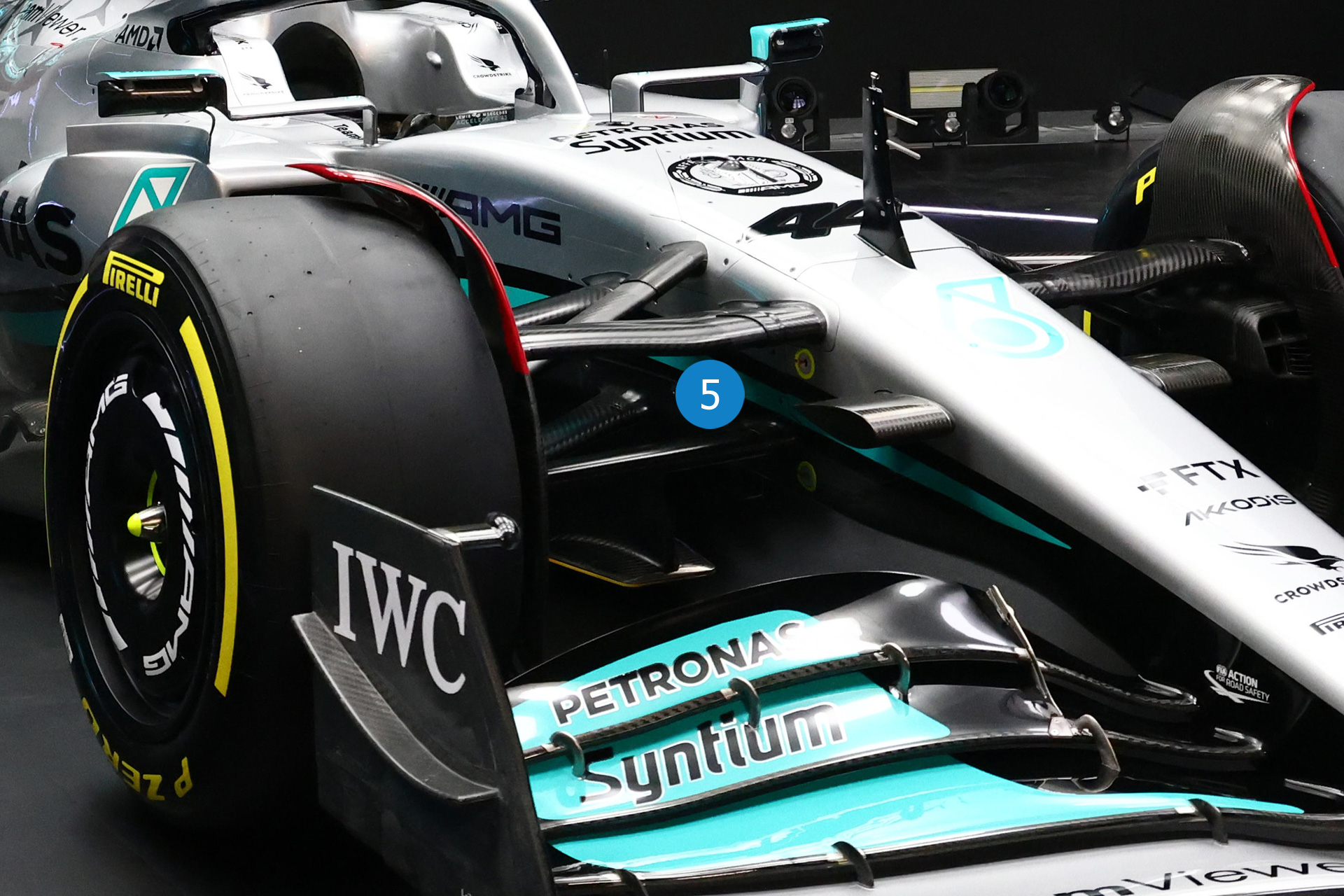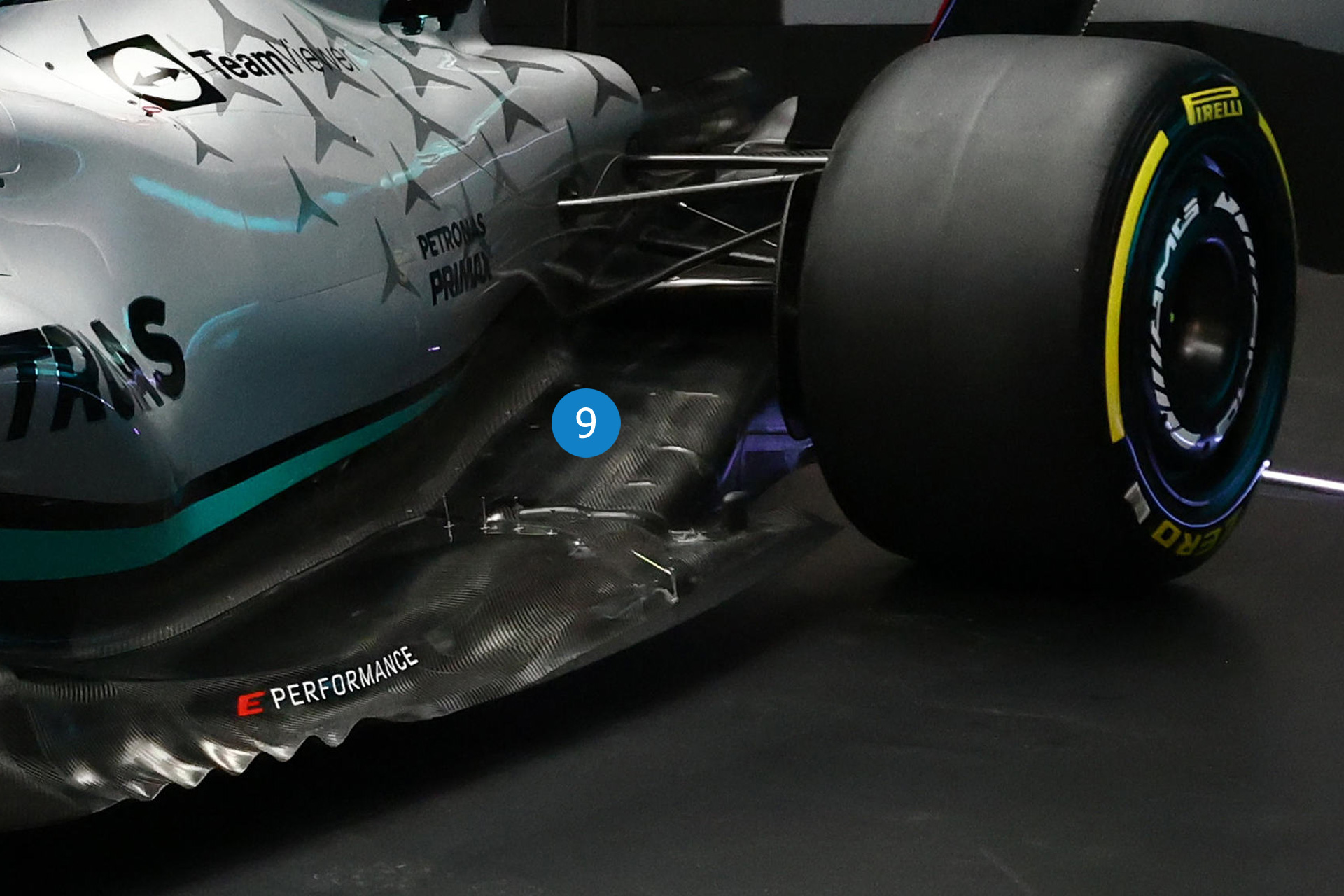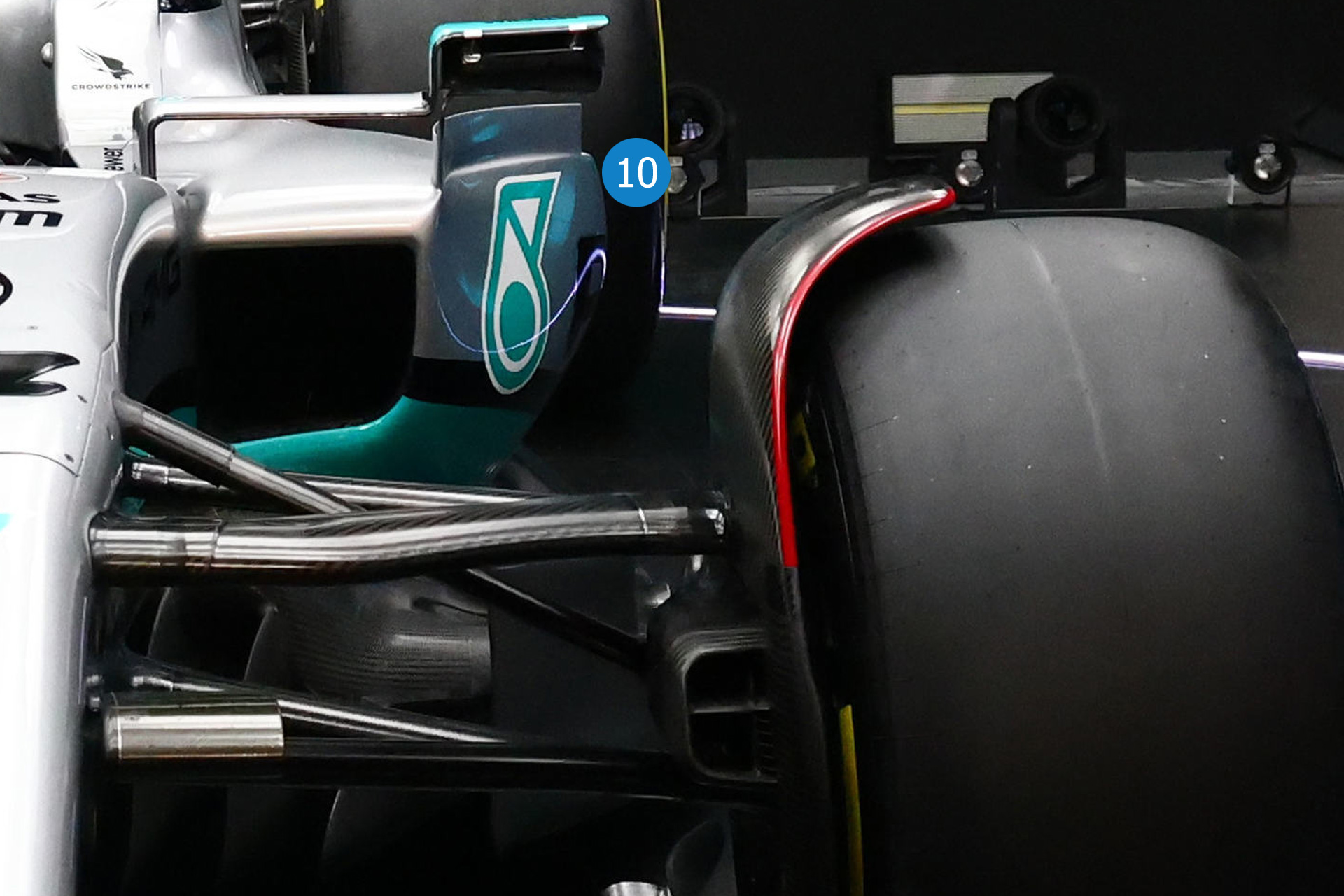
“We can’t rely on past success for this year’s performance,” team principal Toto Wolff admitted, “but we can rely on our people, our culture, our structure, and our mindset to do the best possible job for 2022.”
The renders Mercedes released of the W13 differed from the car which was photographed lapping Silverstone in a few key areas. The W13 revealed during the livestream appeared to be the closest to a track-ready specification we have seen from the launches this year. With all four Mercedes-powered cars having appeared, we can spot the different approaches to packaging taken by the factory team and its customers McLaren, Aston Martin and Williams.
Starting from the front of the car, Mercedes have joined the likes of Ferrari and AlphaTauri by attaching their nose to the main plane of the front wing. The nose itself is boxy and square with a similar profile to that of AlphaTauri and the Aston Martin.
Like the Ferrari, the W13’s nose also seems to have a hole at the tip (1). These small holes could be for driver cooling or to pass some air through to the underside of the nose to help keep the airflow clean. This would have a similar effect to the cars with a gap between the nose and the main plane of the front wing.
Mercedes has strived to keep a similar design philosophy from the W12 on the front wing of the W13. Compared to other teams, the front wing is more ‘outboarded’ with the chord of the elements being relatively consistent all the way out until the boundary provided by the rules (2). The curvature on these elements also suggests that the front wing is more mid-loaded; they attach to the nose further forward providing a clear path for the underfloor inlets (3).
The team may have also tried to re-create the Y250 vortex – a key design trait of the previous generation of cars – using the steep curvature of the wing. The Y250 vortex came to shape aerodynamics in F1 starting in the early 2010s by using the wing-tip vortices formed at the inner tips of upper elements on the front wing. It got its nickname ‘Y250’ as the old regulations stipulated these elements must be no less than 250 mm from the centreline in the horizontal (‘y’) direction.
Advert | Become a RaceFans supporter and
While the new regulations have tried to eliminate the generation of vortices in this region by mandating all front wing elements to the nose, a vortex can still develop in any span-wise (along the width of the wing) change in lift coefficient. On the W13 there is a pronounced change in the steepness of the curvature on the uppermost element (4).
To further help the development of the vortex, a vertical vane is placed in line with the ‘inflection’ point of the curvature (4) indicating that the aerodynamicists at Mercedes are indeed trying to continue building a vortex in the region where the Y250 used to reside. Overall, the angle of attack of the front wing seems to be more aggressive than some of the other teams such as Ferrari and Williams. But no doubt all will try different designs when testing begins on Wednesday.
The general suspension set up of the W13 contains no surprises. Mercedes has gone with the push-rod option in the front and continued to use pull-rod suspension at the rear. However, what is interesting is the top wishbone of the front suspension is not a perfect triangle and in fact contains a kink (5), creating a more dog-legged shape at the front, something that is cleverly hidden in the renders.
It is unclear what the performance benefit of this is, but Mercedes may have been forced into creating this odd shape when trying to integrate the suspension as far forward as possible, away from the sidepod inlets and the inlet of the underfloor to maximize the clean airflow into this vital area of the car’s aerodynamics.
The brake ducts fall in line with Ferrari’s concept. With AlphaTauri, Mercedes, Ferrari, and Williams converging on what seems like similarly-sized brake inlets, it is doubtful that McLaren and Haas will run the small slits they have presented in their renders except on cold days.
Mercedes displayed what appeared to be a track-ready iteration of their floor during their livestream event. It is clear that the aerodynamicists at Mercedes have spent considerable time shaping this concept.
While bargeboards have been outlawed in this new set of regulations, the W13 aims to regain some of this flow conditioning with the inlet to the floor. The outermost vertical vane on the inlet of the floor is considerably shorter than the others (6) and the sculpted section (7) over the top of the underfloor tunnel suggests that a flow field is being passed through and conditioned around the bottom of the sidepod as barge boards previously did. The wavy section on the outer edge of the floor behind this inlet (8) is most likely a vortex generator to effectively ‘seal’ the underfloor to the ground.
It is hard to see the full extent of the diffuser but it can be seen that the diffuser starts quite early and aggressively expands towards the back of the vehicle (9). To accommodate this, the rear suspension has been reworked to sit higher and further forwards than before.
Advert | Become a RaceFans supporter and

The rear half of the sidepod is reminiscent of McLaren’s design and blends into the chassis as quickly as possible without a significant undercut. The engine cover is quite bulbous suggesting that Mercedes has opted to do most of its cooling along the centreline of the vehicle, in and around the power unit. With no cooling louvres to be seen, it seems that the W13 exhausts all of its hot air from their radiators out back towards the upper surface of the beam wing, something seen when the FW44 ran on track.
Mercedes has opted to go for a single swan-neck rear wing mount with the DRS actuator integrated elegantly with the mount (11). The main plane of the rear wing is relatively shallow and the overall shape is similar to that of the McLaren.
Mercedes indicated they have big plans for developing the W13 over the coming pair of three-day tests. “Because the cars will evolve so much over the test, we won’t know where we are until we get to the first race, but we’ve got that mixture of trepidation, excitement of developing the car and seeing what we have created, and pride about what we have achieved together,” said technology director Mike Elliott.
While Mercedes have taken care to conceal some of the W13’s key areas, the world champions were happy to reveal more of their new car than several of their rivals did. Whether or not that confidence is deserved we’ll start to discover when testing begins.
2022 F1 season
- Mercedes told me “you’re wrong” about 2022 car’s problems – Hamilton
- FIA confirms all 10 F1 teams complied with 2022 cost cap
- Steiner “not ashamed” of panning “slow” Schumacher in Drive to Survive
- Albon believes year out of F1 improved him as a driver
- Hamilton sees diversity gains in F1 years on from his ‘traumatising’ experience of racism












RandomMallard
19th February 2022, 17:37
As the final paragraph suggests, Merc very much seem to be planning big revisions to the car before we even reach the first race. Of course all the other teams will be as well, but Merc have been very good at doing this before.
I’m really happy the rules have allowed for a bit more freedom than some people feared. I think it’s going to be difficult to tell them apart from the front (going by the classic thing of paint every car in a plain livery and ask people to identify them), but at the same time I don’t think I would have been great at that on the previous generation, beyond establishing whether the nose was a fairly square one (such as Williams or Ferrari), or one of the curvier, rounded tips like we saw originally on the Mercedes, and later adopted by Renault, RP/AM etc. The thing that’s really fascinated me this year has been the sidepods, the cooling flow into the engine, the louvres (or lack thereof), and how the air is channelled in that part of the car. I also really like the removal of the bargeboards. As clever as they were aerodynamically, they did make the cars look like a bit of a mess in that area.
And really loving these technical analysis articles as well! Keep them coming please!
Matt O'peia
20th February 2022, 13:15
The Louvres really stand out on the AM, and I think at least one other team. It’s hard to believe that they won’t have a significant influence on aerodynamics. + or – I don’t know. It’s a real contrast
RandomMallard
21st February 2022, 17:34
Yeah I think they also really stand out on the Ferrari. But a lot sticks out on that Ferrari.
Kribana (@krichelle)
19th February 2022, 19:16
Nice technical article. It is clear they have done more work to the floor since that is where majority of the downforce comes from, and that this was the reason of their performance loss last season. The floor looks hot as hell really. These cars really look “modernized”. What I would like to know is how much stiffness of the suspension they are running, which is really hard to see unless seen from onboards or touching them and comparing them to other cada.
Jere (@jerejj)
19th February 2022, 19:37
Somewhat off-topic: I don’t know if I’m the only one, but driver numbers on the front-end are hard to tell, something that isn’t the case with other teams, nor even with previous Merc cars.
Yes, a triviality, but I wanted to bring this up as I’ve found distinguishing them hard in the shakedown images.
Oh well, helmets are enough & I generally rely on them more than numbers anyway.
Tristan (@skipgamer)
19th February 2022, 19:55
The wavy (8) section can’t be cheap to manufacture right? Such an attractive feature. Hope to see more of that kind of thing, hopefully it doesn’t circumvent the regulations intentions and isn’t too expensive for the smaller teams.
Only Facts!
19th February 2022, 20:35
One characteristic mentioned by Mercedes was building a car that can “survive the track”.
Do they mean that they’re expecting close wheel to wheel battles, lots of contacts, and they want the car to “survive” and keep racing?
Thick carbon fiber suspension arms that can take some beating while still maintaining its shape?
Pop corn ready!
andrewp (@andrewp)
20th February 2022, 12:00
Maybe to not have to tell a driver to avoid taking a certain kerb during the race?
F180 (@f180)
19th February 2022, 21:22
It’s a beast
Mark (@blueruck)
19th February 2022, 21:46
Another great write up Alto. Thank You
Sensord4notbeingafanboi (@peartree)
20th February 2022, 1:47
Unsurprisingly the merc looks a lot more sophisticated than their opponents as as been the case lately.
floodo1
20th February 2022, 2:28
Thx
spoutnik (@spoutnik)
20th February 2022, 10:25
Stunning details, really. Something I did not appreciate fully with the short video of the car getting out of the garage, but it looks absolutely organic. What a beautiful piece of engineering !
I’m curious about the floors of these cars, we’ll have to wait for a car to be lifted up to get a chance. The Mercedes one looks like a piece of art already from the upper side.
Denis (@denis1304)
20th February 2022, 12:00
How is Mercedes justifying vertical vain on the floor seen on the picture 9 and 11, between diffuser and tire.
MacLeod (@macleod)
21st February 2022, 8:46
I think that is a gray area which we have to see it would be on the car for the first race.
Wayne
20th February 2022, 16:07
Awsome info on the merc thanx!!! The merc is either gona smash the pack or be part of the pack.
iCarbs (@icarby)
20th February 2022, 16:32
I think Mercs optimised their previous philosophies but simply added in the constraints of the current regs, they seem very confident as it looks like they didn’t really need to start totally from scratch.